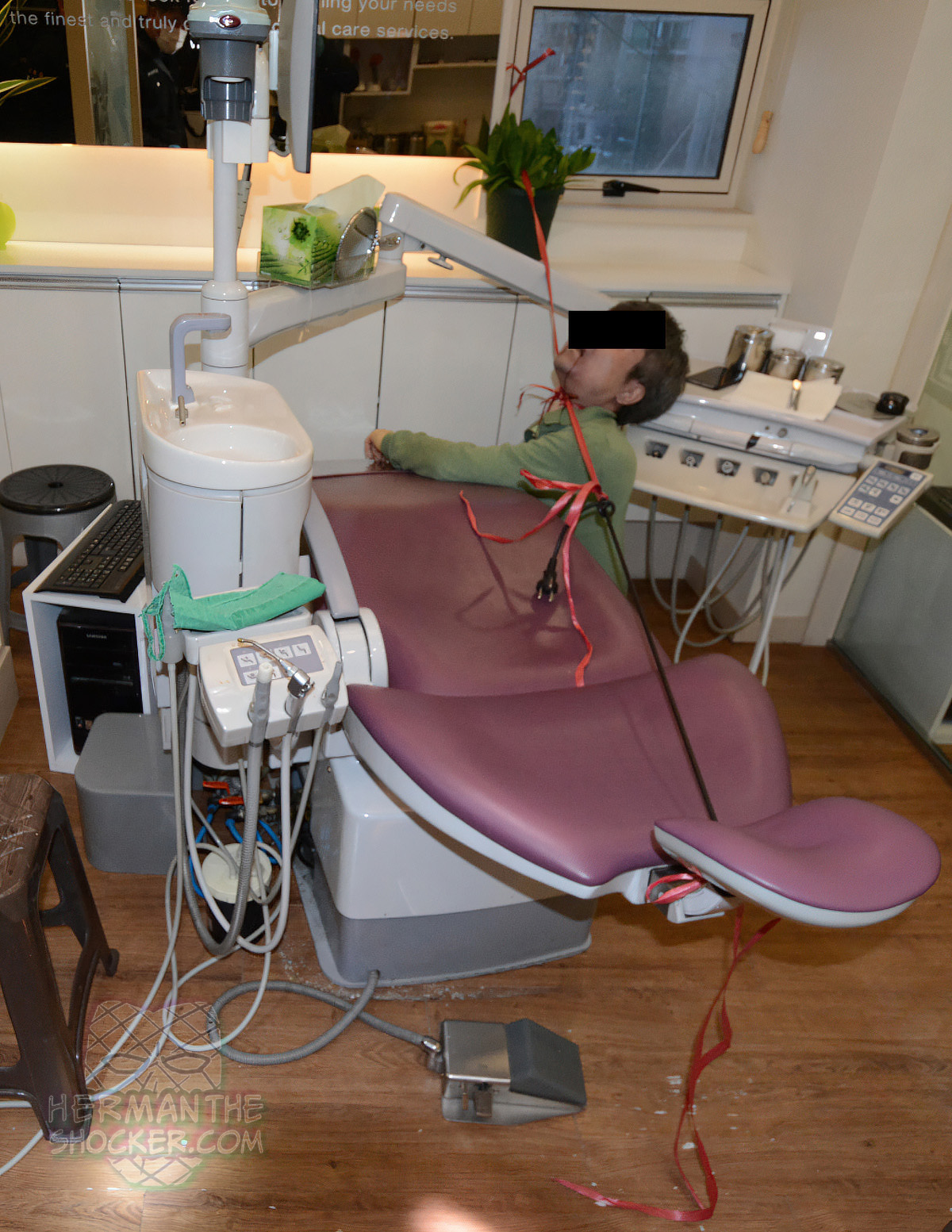Seoul, South Korea. The victim, a 46-year-old male dentist, was found dead of ligature strangulation next to a dental unit at the dental clinic where he worked. The victim was squatting next to the dental unit. He was on his knees, with both feet on the floor. His left hand was resting on the dental chair, with his right hand facing the floor, and his face looking up at the ceiling.
The ligature consisted of multiple strands of pink nylon ribbon and a power cable with the ends tied together. One end of the ligature was attached to the window frame with pink nylon ribbon. It was wrapped very tightly around the victim’s neck once with a noose and tied at the midpoint of the victim’s neck and at the head of the dental chair with pink nylon ribbon and a power cable. The knot around the victim’s neck was located between the thyroid cartilage and the mandible, with the noose below the angle of the right mandible. The dental unit was switched on. Button 1 (the recline button) on the dental unit’s control panel was pressed and the chair was reclined to the horizontal position. This was confirmed by repeated testing.
The position of the victim upon discovery meant that he could not have reached out and touched the window frame or the head of the dental chair. On examining the death scene, a plastic container containing pink nylon ribbon was found near the victim. The environment was undisturbed, and there were no signs of an altercation having taken place. Possible criminal activity was considered, and evidence collected at the scene was secured.
The victim was taken to a nearby funeral home for medicolegal death investigation. The victim was a 46-year-old male (171 cm in height (5′ 7″) with a normal body weight). Rigor mortis was observed in the chin, neck, and legs. Livor mortis appeared as migratory dark red patches on the right hand, back of the neck, back, and behind both legs. Facial congestion was observed, with multiple petechiae on the face and both eyelid conjunctiva, ocular conjunctiva, and oral mucosa.
Bloodstain pattern analysis confirmed the longitudinal flow pattern (nostrils–chin–neck–chest–navel [i.e., in the direction of gravity]). The saturation pattern on the front of the T-shirt was consistent with the flow pattern. The pool pattern at the end of the flow (around the navel on the front of the T-shirt) was partially analyzed. No other remarkable findings were observed. The position of the knot at the front of the neck was consistent with suicide. Nobody had visited the clinic, autopsy found no drugs in his system, and the environment was undisturbed. Homicide was ruled out.
The victim’s occupation was a dentist. He worked as a dental director in Seoul. According to the statement of a dental office employee who had worked with him, the victim had been in litigation with the owner of the building where his clinic was located for some time and had problems paying rent. According to the victim’s family, he had been depressed and had been in legal disputes with the owner of the building where his clinic was located. There were no reports of the victim having engaged in any unusual sexual or autoerotic activity, and he had not received any death threats. According to the statement of a dental office employee, the victim had psychological and financial difficulties while in litigation with the owner of the building where his clinic was located for some time over rent payments. He had not received any death threats. Approximately 1 h before his death, he sent a suicide text message to his wife.
According to the World Health Organization, suicide is a serious global health problem, with over 700,000 deaths annually. In 2019, more than 1 in 100 deaths (1.3%) were due to suicide. Suicide is a leading cause of death worldwide, accounting for more deaths than homicide, war, breast cancer, human immunodeficiency virus/acquired immune deficiency syndrome, and malaria. Globally, hanging is the most common form of suicide. As of 2019, the Republic of Korea had the highest age-standardized suicide rate, which reached 24.6 (higher than that of the Organization for Economic Co-operation and Development [OECD] [average, 11.3]. The most common cause of suicide is psychological pain, followed by financial difficulties, disease, and family issues.
Latest posts







![Fig.4 Bloodstain pattern analysis confirmed the longitudinal flow pattern (nostrils–chin–neck–chest–navel [i.e., in the direction of gravity]).](https://i0.wp.com/www.hermantheshocker.com/wp-content/uploads/2022/12/004-6.jpg?fit=1200%2C491&ssl=1)




